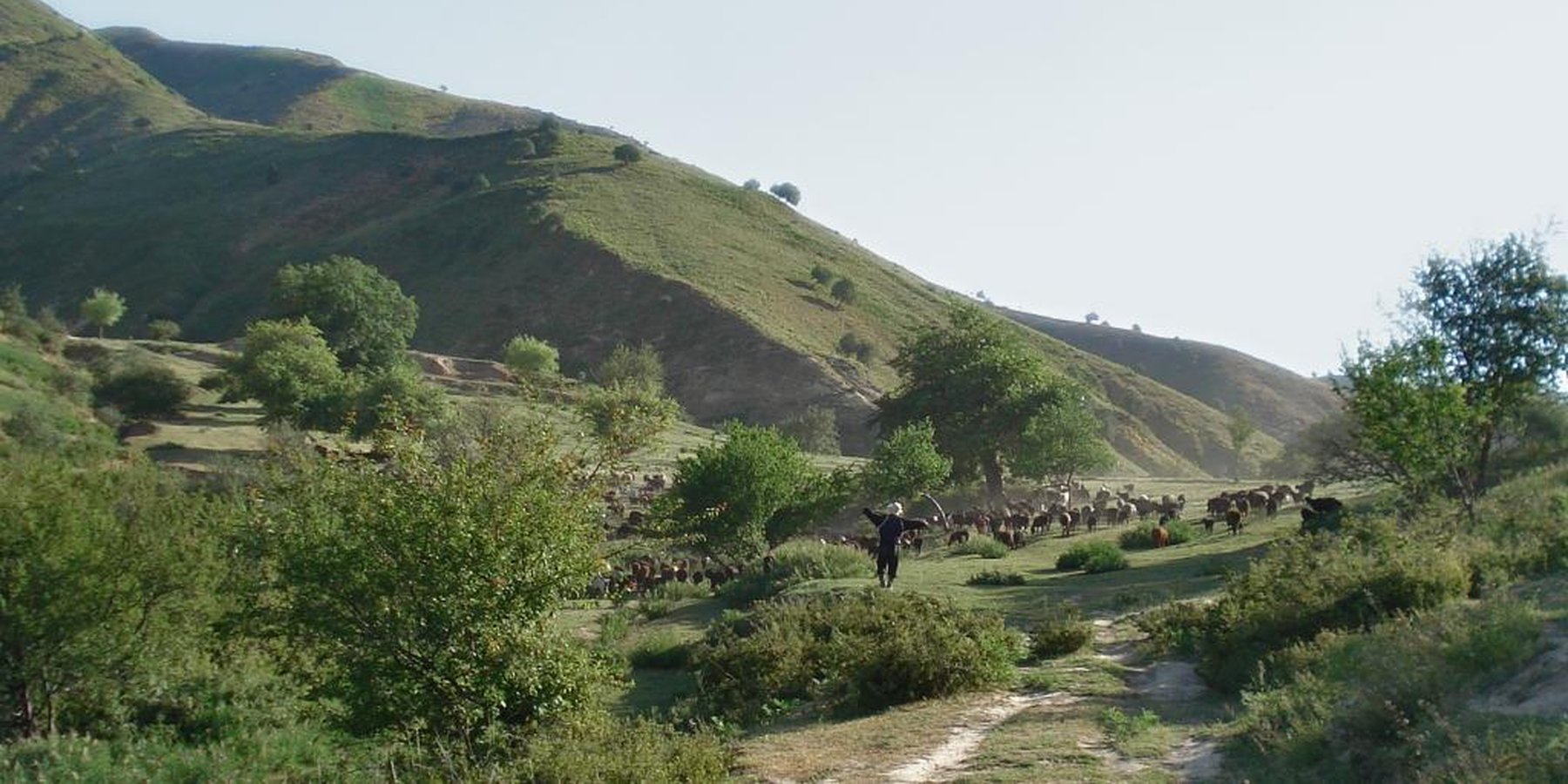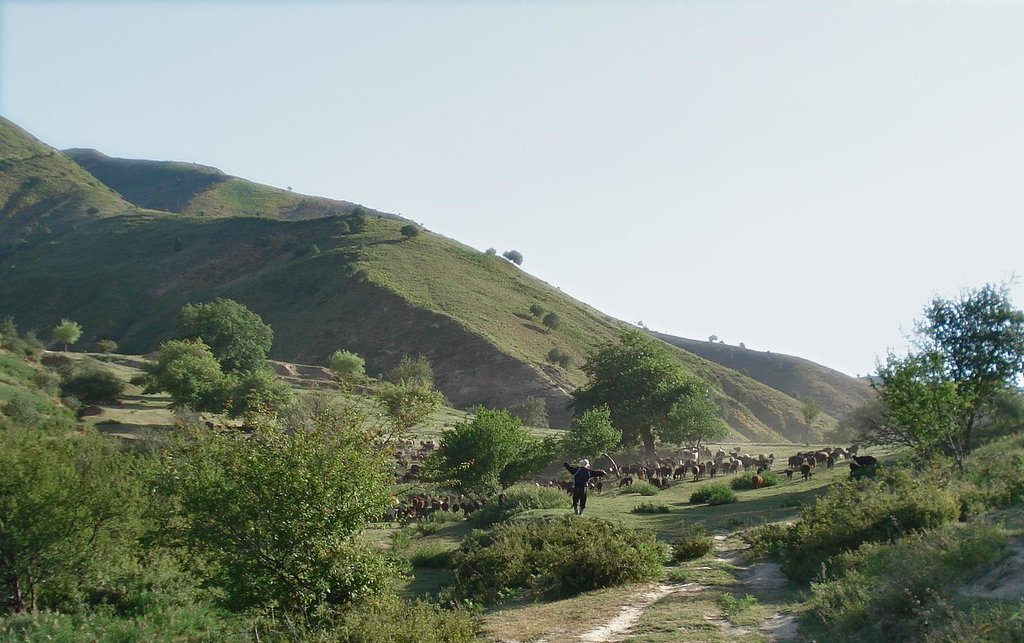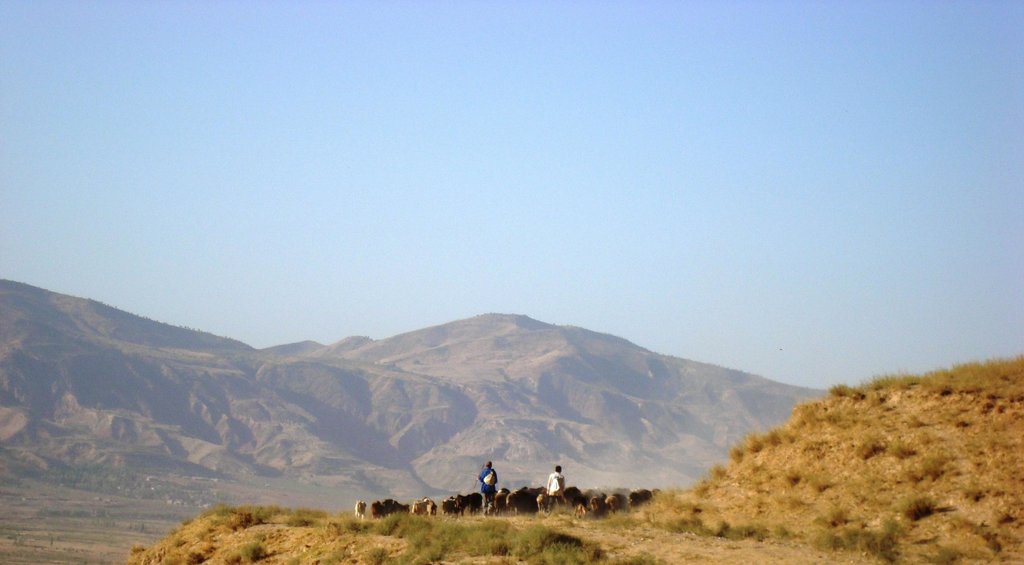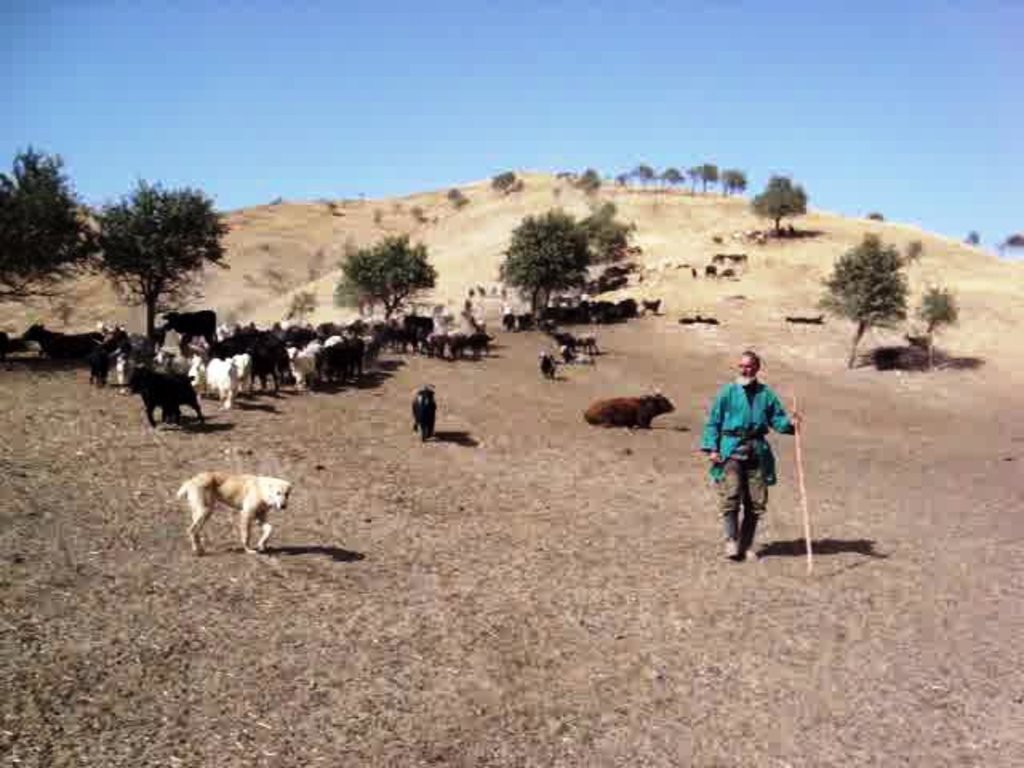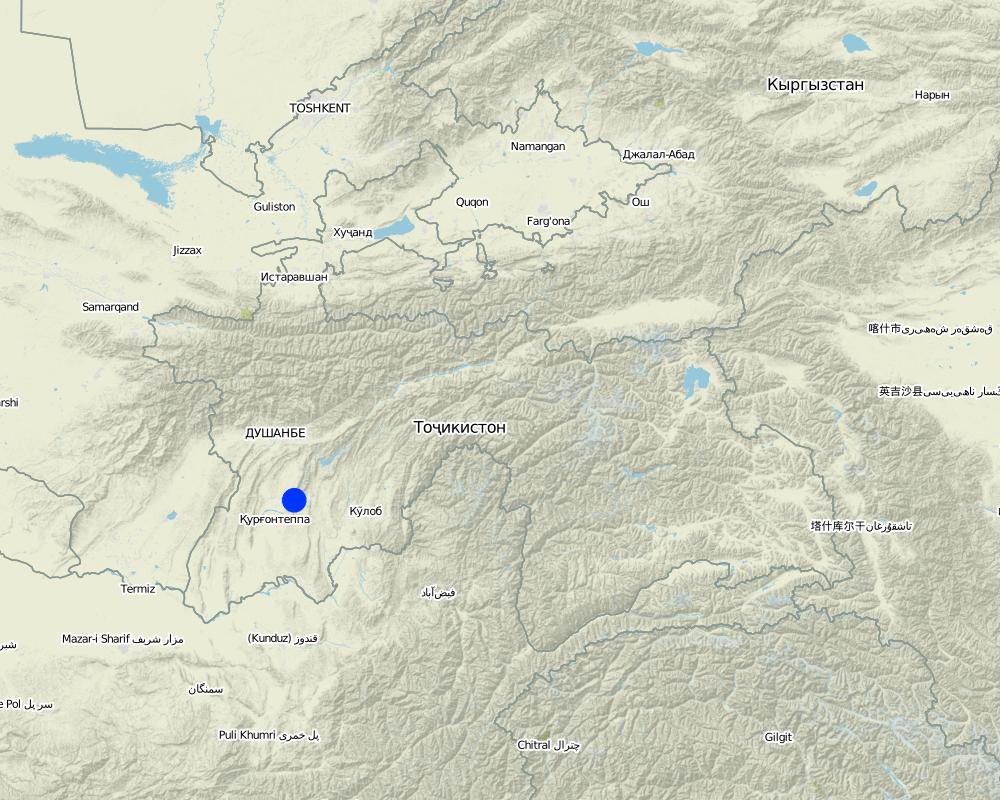Seminomadic individual herding [طاجيكستان]
- تاريخ الإنشاء:
- تحديث:
- جامع المعلومات: Christian Wirz
- المحرر: –
- المُراجع: David Streiff
Chupon / Dajmardei Khaspi (professional herding)
approaches_2565 - طاجيكستان
عرض الأقسام
توسيع الكل طي الكل1. معلومات عامة
1.2 تفاصيل الاتصال بالأشخاص الرئيسيين لمصدر المعلومات والمؤسسات المعنية بتقييم وتوثيق النهج
اسم المؤسسة (المؤسسات) التي سهلت توثيق/تقييم النهج (إذا كان ذلك على صلة)
CDE Centre for Development and Environment (CDE Centre for Development and Environment) - سويسرا1.3 الشروط المتعلقة باستخدام البيانات الموثقة من خلال WOCAT
متى تم تجميع البيانات (ميدانيا)؟:
15/08/2008
يوافق جامع المعلومات والشخص (لاشخاص) الرئيسي لمصدر المعلومات على الشروط المتعلقة باستخدام البيانات الموثقة من خلال WOCAT:
نعم
1.4 المراجع الخاصة باستبيان(استبيانات) تقنيات الإدارة المستدامة للأراضي
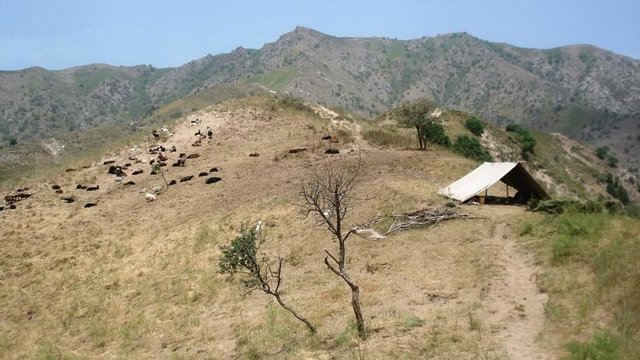
Daily and seasonal rotation on grassland [طاجيكستان]
Extensive grazing of sheep and goats by the means of a precise rotational scheme
- جامع المعلومات: Christian Wirz
2. وصف نهج الإدارة المستدامة للأراضي
2.1 وصف موجز للنهج
Pasture management by a single herder, assisted either by an employee or by his own grandchildren, in collaboration with the habitants of the nearby village Karsang.
2.2 وصف تفصيلي للنهج
وصف تفصيلي للنهج:
Aims / objectives: The herder chooses his territory by the criteria of biomass, vegetation cover and availability of surface water. In his work he gives special attention to fattening the animals, to not losing any of them and to giving back the right animals to the right tenant at the end of the season. For him it is important to be sincere with the tenants and to pay for lost animals.
Methods: Every method applied serves the target of having an obeying herd. The herder works with lots of patience. In the first two weeks he pays very much attention to keeping the herd together, so the animals get used to each other. The rotational grazing scheme also fulfills the requirement of fattening the animals. Grazing the animals by night-time is a method to make the animals obey better. Part of the work is the daily control of the herd to identify sick animals and treat them.The animals are by the way not led by the herder, but rather accompanied by him.
Stages of implementation: After apprenticeship the herder is entrusted with animals from the village and with the generated income can then gradually build up his own herd.
Role of stakeholders: The herder is responsible for the relation with his animals, with the villagers and with the forest department (contract).
2.3 صور عن النهج
2.5 البلد/المنطقة/المواقع التي تم تطبيق النهج فيها
البلد:
طاجيكستان
المنطقة/الولاية/المحافظة:
Region of Republican Subordination
مزيد من التفاصيل حول الموقع:
Faizabad
Map
×2.6 تواريخ بدء وإنهاء تنفيذ النهج
أشر إلى سنة البدء:
1987
2.7 نوع النهج
- تقليدي/أصلي
2.8 الغايات/الأهداف الرئيسية للنهج
The Approach focused mainly on other activities than SLM (The focus of this approach is providing the own family with income and meat, by herding own and animals of other herders. It is very important for the herder to keep the animals healthy and to give them all back (the fattest possible) to their tenants.)
The herder's motivation to continue his father's work was that it enabled him to nourish his family. In his work he pays attention to fatten the animals enough to make them survive winter and to give them all back.
The SLM Approach addressed the following problems: The inhabitants of the village give the herder their animals because they know that the animals will be more healthy on the more natural pastures frequented by him compared with village pastures and because the animals get more reserves for winter-time. The herder claims that the animals need 50% less hay and fodder in winter than the animals grazed near the villages.
2.9 الظروف التي تمكن أو تعيق تنفيذ التقنية/التقنيات المطبقة بموجب النهج
المعايير والقيم الاجتماعية /الثقافية/ الدينية
- معيق
Being unable to go to parties and weddings.
Treatment through the SLM Approach: As it is not a problem for the herder (but perhaps for his wife and family?) the problem is not tackled.
توفر/الوصول إلى الموارد والخدمات المالية
- معيق
Paying for lost animals.
Treatment through the SLM Approach: As long as the herder can find the lost animal, even if it is dead, he will not have to pay for it.
الإطار المؤسساتي
- معيق
It is necessary to have good relations to obtain land from the forest administration.
Treatment through the SLM Approach: As M. worked for the forest department for many years, it was not a problem for him to lease land.
الإطار القانوني (حيازة الأراضي، وحقوق استخدام الأراضي والمياه)
- تمكين/تمكيني
If tenure were more secure and land use free, M. would divide the rented land into pasture zone, orchard and cropland. This would ensure more self-sufficiency, but probably less income, because he could keep less animals on the reduced pasture area
- معيق
غير ذلك
- معيق
For M. the principal problem are bears (and wolves) killing animals.
Treatment through the SLM Approach: Since he is not allowed to have a rifle to kill wild animals he has to chase them away with his dogs. This means that in summer, when the bears descend to lower areas for fruit in the orchards, he often has to keep awake by night.
3. المشاركة وأدوار الأطراف المعنية
3.1 أصحاب المصلحة المعنيون بالنهج وأدوارهم
- مستخدمو الأراضي المحليون/المجتمعات المحلية
The herder himself is the protagonist. In some years he employed and educated young herders.
إذا كان هناك العديد من الأطراف المعنية، قم بالإشارة إلى الوكالة الرائدة:
The herder himself implements the approach
3.2 انخراط مستخدمي الأراضي المحليين/المجتمعات المحلية في المراحل المختلفة للنهج
| انخراط مستخدمي الأراضي المحليين/المجتمعات المحلية | حدد من شارك وصف الأنشطة | |
|---|---|---|
| المبادرة/التحفيز | التعبئة الذاتية | Deciding to be a herder |
| التخطيط | غير موجود | |
| التنفيذ | التعبئة الذاتية | Once M. knew how to treat the animals he could begin work with an own herd. |
| الرصد/التقييم | غير موجود | |
| Research | غير موجود |
3.4 اتخاذ القرار بشأن اختيار تقنية/تقنيات الإدارة المستدامة للأراضي
حدد من الذي قرر اختيار التقنية/التقنيات التي سيتم تنفيذها:
- مستخدمو الأراضي وحدهم (المبادرة الذاتية)
اشرح:
The herder learnt his profession during an apprenticeship of one year
Decisions on the method of implementing the SLM Technology were made by by land users* alone (self-initiative / bottom-up). M. learned all the technologies from his father, but says, that he only does his job half as well as his father.
4. الدعم الفني وبناء القدرات وإدارة المعرفة
4.1 بناء القدرات/التدريب
هل تم تقديم التدريب لمستخدمي الأراضي / الأطراف المعنيين الآخرين؟:
نعم
حدد من تم تدريبه:
- موظفون ميدانيون/ مستشارون
إذا كان ذلك على صلة، حدد الجنس والعمر والوضع والعرق وما إلى ذلك.
Young men and boys.
شكل التدريب:
- في العمل
المواضيع المغطاة:
Teaching of herding method: He tells his assistants not to beat the animals, not to shout at them, to treat animals fairly so they obey and to nourish them sufficiently so they don't walk away by night.
4.2 خدمة استشارية
هل يملك مستخدمو الأراضي وصولا إلى خدمة استشارية؟:
كلا
4.4 الرصد والتقييم
التعليقات:
There were no changes in the Approach as a result of monitoring and evaluation: None
There were no changes in the Technology as a result of monitoring and evaluation: None
5. التمويل والدعم المادي الخارجي
5.1 الميزانية السنوية لمكون الإدارة المستدامة للأراضي في النهج المذكور
إذا لم تكن الميزانية السنوية الدقيقة معروفة، قم بالإشارة إلى نطاقها:
- < 2000
التعليقات (على سبيل المثال المصادر الرئيسية للتمويل/الجهات المانحة الرئيسية):
Approach costs were met by the following donors: local community / land user(s) (All costs): 100.0%
5.2 الدعم المالي/المادي المقدم لمستخدمي الأراضي
هل حصل مستخدمو الأراضي على دعم مالي/ مادي لتنفيذ التقنية/ التقنيات؟:
كلا
5.3 إعانات لمدخلات محددة (بما في ذلك العمالة)
إذا كان العمل من قبل مستخدمي الأراضي مدخلاً جوهريًا، فهل كان:
- الغذاء مقابل العمل
التعليقات:
Also paid in cash: Whereas his grandsons help him and get food therefore, the herder sometimes employs assistants who are paid.
5.4 الائتمان
هل تم توفير ائتمان في إطار نهج أنشطة الإدارة المستدامة للأراضي؟:
كلا
6. تحليل الأثر والتصريحات الختامية
6.1 آثار النهج
هل ساعد النهج مستخدمي الأراضي على تنفيذ وصيانة تقنيات الإدارة المستدامة للأراضي؟:
- لا
- نعم، قليلا
- نعم، باعتدال
- نعم، إلى حد كبير
More biodiversity, less fertility decline, less cover reduction (compared to the grazing method used near the villages)
هل ساهم النهج في تمكين الفئات المحرومة اجتماعيا واقتصاديا؟:
- لا
- نعم، قليلا
- نعم، باعتدال
- نعم، إلى حد كبير
Did other land users / projects adopt the Approach?
- لا
- نعم، قليلا
- نعم، باعتدال
- نعم، إلى حد كبير
Young men herding in Faizabad area, one of them only a few ridges in the east of M.
Did the Approach lead to improved livelihoods / human well-being?
- لا
- نعم، قليلا
- نعم، باعتدال
- نعم، إلى حد كبير
Whereas in the villages every family has to send someone as a herder once per month, M. earns money for his job and breeds his own animals. On the other hand the family structure is disrupted by the c
Did the Approach help to alleviate poverty?
- لا
- نعم، قليلا
- نعم، باعتدال
- نعم، إلى حد كبير
In finacial terms, it did (by generating income), But in terms of education, it did not help.
6.2 المحفز الرئيسي لقيام مستخدمي الأراضي بتنفيذ الإدارة المستدامة للأراضي
- زيادة الإنتاج
Animals get fatter than on the common pastures
- الوعي البيئي
The herder somehow has a consciousness of only taking from nature for what he has paid
6.3 استدامة أنشطة النهج
هل يمكن لمستخدمي الأراضي المحافظة على استدامة ما تم تنفيذه من خلال النهج (بدون دعم خارجي)؟:
- نعم
إذا كانت الإجابة بنعم، صف كيف:
The herder intends to continue his work as long as physically possible. He though wants to take less animals in the following year and instead more cows and less sheep and goats. He says that cows are easier to keep and in addition, he is paid four times more for a cow than for a sheep or a goat.
6.4 نقاط قوة/مزايا النهج
| نقاط القوة/ المزايا/ الفرص من وجهة نظر مستخدمي الأراضي |
|---|
| Each tenant has animals with their own comportment. M. only has to deal with a little number of tenants (and thus animal comportments), whereas the village herds are composed by animals of much more tenants. |
| animals can get used to each other. The composition of the big village herd is not always the same. |
| The herder is always the same and treats the animals fairly: he leads the animals slowly and doesn't shout at them or beat them. |
| نقاط القوة/ المزايا/ الفرص من وجهة نظر جامع المعلومات أو غيره من الاشخاص الرئيسيين لمصدر المعلومات |
|---|
| With around 600-700$ per season, the work as a professional herder is quite well-paid (for rural areas). (How to sustain/ enhance this strength: As soon as work in the foreigner (especially Russia) becomes scarce, herding will be more attractive again.) |
| For people with a tight relationship to nature and god (in the case of M.) this area is a good place, since remote. (How to sustain/ enhance this strength: There will probably continue to be religious, nature-bound young people.) |
6.5 نقاط الضعف/ العيوب في المنهج وطرق التغلب عليها
| نقاط الضعف/ المساوىء/ المخاطر من وجهة نظر مستخدم الأراضي | كيف يمكن التغلب عليها؟ |
|---|---|
| The trees damaged by the animals are a problem from the herder's point of view. | He sees the main problem in the past civil war, when lots of trees were chopped illegally. He says that tree-planting would not be a solution, because then grazing would not be possible anymore either. |
| نقاط الضعف/ المساوىء/ المخاطر من وجهة نظر جامع المعلومات أو غيره من الاشخاص الرئيسيين لمصدر المعلومات | كيف يمكن التغلب عليها؟ |
|---|---|
| The way of living is not modern in the young peoples' eyes: They prefer social and urban to rural, solitary life. | As long as poverty predominates in the villages and cities cannot offer enough jobs to young people, agriculture and herding will stay interesting. Though, new (old) forms of herding might appear, such as herding in groups. |
| Night grazing makes sheep eat impalatable (poisonous) plants and than become sick (according to a specialist from CARITAS). | Training and workshops could be a platform for the discussion of such critical aspects. |
الروابط والوحدات المواضيعية
توسيع الكل طي الكلالروابط

Daily and seasonal rotation on grassland [طاجيكستان]
Extensive grazing of sheep and goats by the means of a precise rotational scheme
- جامع المعلومات: Christian Wirz
الوحدات المواضيعية
لا يوجد وحدات مواضيعية


